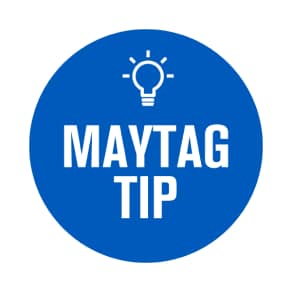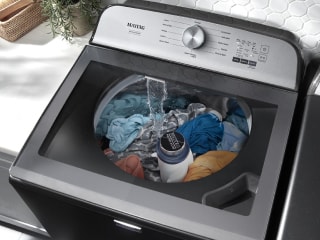
How to Use a Top Load Washing Machine
With the right supplies and know-how, you can master moving laundry through the preparation stages and on to washing. Use this guide to learn more about what you need to get started, six steps to take when washing and how to identify common washer noises. You’ll get the most out of your machine with these quick tips for how to use your top load washer.
How to Load a Top Load Washing Machine
Taking the correct steps to prep clothes and learn your washer’s settings will help you tackle everything from lightly soiled delicates to t-shirts caked in mud. Gather the laundry supplies below, then walk through the six steps to help you sort clothes, prepare laundry additives, load the washer and select the right settings.
Supplies
- Laundry detergent
- Stainfighters (optional)
- Stain remover (optional)
- Fabric softener (optional)
- Dryer sheets (optional)

Step 1: Check Installation Before Starting Your Laundry
Ensure all feet are in firm contact with the floor and locked.
Make sure the washer and dryer are far enough apart that they don't touch when in use.
- Confirm that both hot and cold water hoses are connected to the appropriate inlet valves.
- Follow our guide to installing a top-load washer to make sure your washer is installed properly.

Step 2: Sort Laundry
Separating laundry by color, fabric type and weight can help keep clothes looking newer for longer. To sort clothing:
Separate whites from colors.
Divide colors into pastels and darker hues, then separate out darker reds, oranges and yellows from dark greens, blues and purples.
Wash new, bright items separately for the first several washes.
Create groupings of fabrics with similar weights to avoid damaging clothing fibers.
Fasten hooks, tie strings and close zippers

Step 3: Add Detergent
- Pour detergent in the dispenser or, if there isn’t one, directly into the tub before adding clothes. Always follow the instructions on the packaging when measuring.
- If your washer is High-Efficiency (HE), only use HE detergent. Learn more about HE detergent with this quick guide.
- If using detergent pods, detergent sheets, color-safe bleach or fabric softener crystals, add them directly to the tub before loading clothes. Do not put in the dispenser or on top of clothes.
- Use designated dispensers when adding liquid chlorine bleach and fabric softener. Check your owner’s manual for specific instructions.
- Find out how different types of laundry detergents compare.

Maytag recommends Swash® Laundry Detergent.1 Its Precision Pour Cap prevents overpouring and waste. Use one squeeze for regular loads and two for large loads. Swash® Laundry Detergent’s 8x concentrated formula can be used in all machines. You get 4x more loads with the same amount of detergent.2

Step 4: Load Top Load Washer
- Load hard-to-move bulky items first for better interaction with the agitator or impeller.
Throw items in loose heaps evenly around the agitator or impeller so they have room to move.
When washing bulky single items like a rug, winter jacket or a heavy denim jacket add a few extra items around the tub to balance the weight. If unbalanced, it can cause your washer to walk or shake.

Step 5: Add Fabric Softener and Stainfighters (Optional)
Using the right amount of fabric softener helps prevent build-up on your clothes and washer while still softening the fibers of your clothing. Add fabric softener by first locating your washer’s designated fabric softener dispenser—typically on the top of the agitator—then measuring out and adding the amount of softener instructed on the fabric softener packaging. Follow the instructions on the packaging of stainfighters to make sure you’re using the correct amount at the right time.

Step 6: Select Washer Cycle
Factors like fabric type, clothing dyes and item weight can all influence which cycle you choose, so it’s best to reference your clothing’s care tag for specific instructions. Check out common top load washer cycles below to learn more about which cycle to choose.
Normal: Ideal for normally soiled linens, sheets, cottons and mixed garment loads.
Heavy: Use for heavily soiled loads of sturdy items.
Whites: Best for heavily soiled white fabrics.
Delicates: Also known as a “gentle” cycle and best for lightly soiled sheer fabrics, lingerie, blouses and more.
Quick wash: Ideal for small, lightly soiled loads that need quick cleaning.
Rinse/Spin: Best for rinsing clothes like swimwear that don’t need detergent.
- Bulky: Sometimes known as a “bedding” cycle and best used when washing items like jackets and small comforters.
Once selected, you can continue to modify the wash cycle with various options like deep fill or extra rinse. Select Maytag® washers feature additional options like the Extra Power button and Deep Fill option. The Extra Power button uses a dual-temperature wash to boost stain-fighting performance while the Deep Fill option fills the wash basket with deeper water to help rinse away tough messes.

FIND THE BEST WASHER FOR YOU
Recognize Different Top Load Washer Cycle Noises
At different stages of the wash cycle, you might hear noises that sound different from your previous washer.
- Clicking at the beginning of the cycle means the washer is locking the lid in place and testing that it’s secure.
- Humming and whirring sounds occur when the agitator is moving the load or the tub is slowing down.
- Silence may indicate that the washer is soaking clothes or determining the right water level for your load.
A buzzing noise may sound at the end of the wash cycle to indicate that the washer is finished. Some models allow you to turn this alert off or adjust the volume.

Maytag® washing machines
Designed for performance, control and convenience
Maytag® washing machines take stain fighting seriously with cycles built to push the limits of power
Explore Maytag® Top Load Washers
Rely on Maytag® top load washers to tackle tough messes and large loads. Find the features that fit your family’s needs when you shop top load washers in traditional white and metallic slate finishes, with agitator or impeller options, from Maytag brand.
Was this article helpful? Pass it on
EXPLORE MORE FROM MAYTAG BRAND
1. Swash and the recommended brands are owned and distributed by Whirlpool Corporation.
2. Vs. a traditional 2x detergent.








